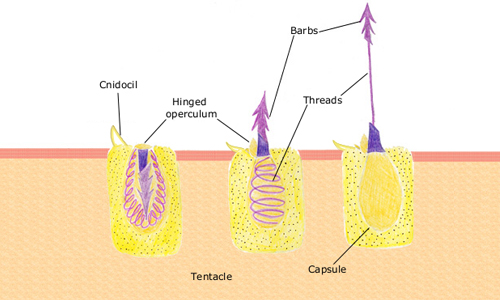Difference between Cnidocyte and Nematocyst
Introduction
A Cnidocyte is also called as a cnidoblast or a nematocyte. A cnidocyte is an explosive cell having within it a giant secretory organelle (organ) called cnida which is a characteristic of the phylum Cnidaria. A Nematocyst is a specialized sub-cellular organelle (part of the cell) present in cnidocyte. Thus, a nematocyst is essentially a part of a cnidocyte.
The Phylum Cnidaria consists of corals, jelly fish, anemones, hydrae and other animals that have elongated bodies. They are characterized by their excellent skills of hunting which they use to get their prey. Cnidarians are known for their defensive skills as well due to the presence of cnidocytes which possess a specialized sub-cellular organelle.
Features of a cnidocyte
A cnidocyte is a defense mechanism present in the coelenterates species of organisms that helps them attack their prey. There are venomous cells present in the bodies of organisms of the phylum cnidae that are shot at the bodies of the prey as soon as their presence is felt. A nematocyst is present inside each cnidocyte for defence as well as offence. The moment the organism has an enemy around, it fires off the nematocyst which can be used only for a single firing. The fired menatocyst contains venom and will inject the neurotoxin in the body of the prey leading to paralysis on the central nervous system.
A Cnidocyte is present in the exodermal layer of the organism i.e. it is present in the tips of the tentacles of the organism. The bodies of the organisms present in the cnidarian phylum are very simple morphologically and hence these organisms are sessile most of the time.
Types of cnidocytes
The cnidae could be of penetrant variety, glutinant variety, volvent variety or ptychocyst variety. A Nematocyst is a penetrant variety of cnidocyte which means it ejects a sharp structure which penetrates the body of the prey to paralyze it.
A Nematocyst is bulb shaped structure, covered by a capsule which has coiled thread like structure at the base of it and a hair like structure which acts like a trigger. A Nematocyst contains a hollow filament inside which is barbed. The barbed filament and the poison together make the attack potentially dangerous and thus do not allow escape of even minute prey. This trigger activates the nematocyst and releases the thread-like coiled structure that delivers the poison. This barb travels at a very high speed; hence there is no chance of the prey escaping.
This property helps the organisms from phylum Cnidaria attack even huge animals in a matter of few seconds. These organisms will have to be extremely cautious while activating the nematocysts as they actually can injure themselves if the direction of the firing is not appropriate.
Summary
Organisms from the phylum Cnidaria contain a special mechanism to defend their soft bodies and help get their prey. They contain a special organ called as a cnidocyte. This cnidocyte contains a poisonous sub-cellular cell called as a nematocyst that the organism fires on its prey. The nematocyst is thus a small part of a cnidocyte.
- Difference between near sightedness and far sightedness - January 21, 2015
- Difference between Diverticulosis and Diverticulitis - January 20, 2015
- Difference between Prilosec and Nexium - January 19, 2015
Search DifferenceBetween.net :
Leave a Response
References :
[0]http://upload.wikimedia.org/wikipedia/commons/b/b0/Nematocyst_discharge.png

